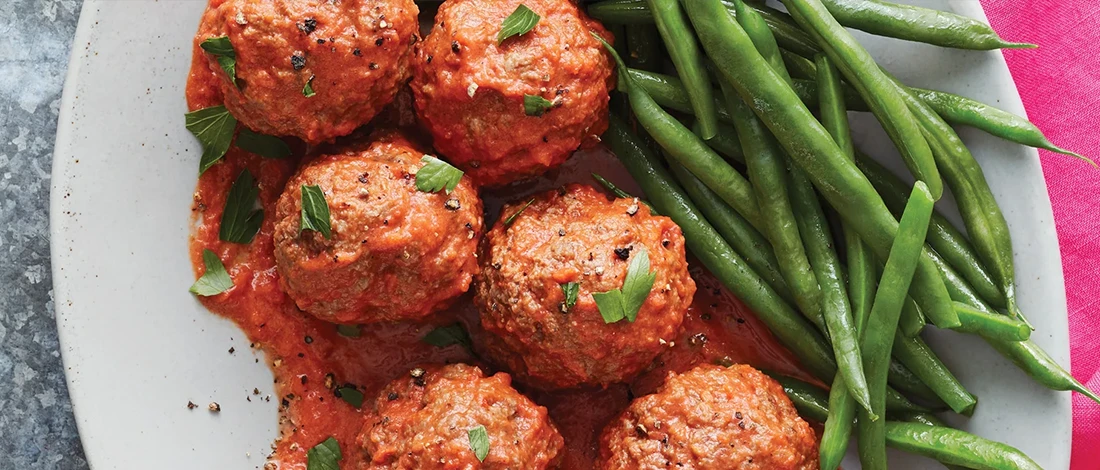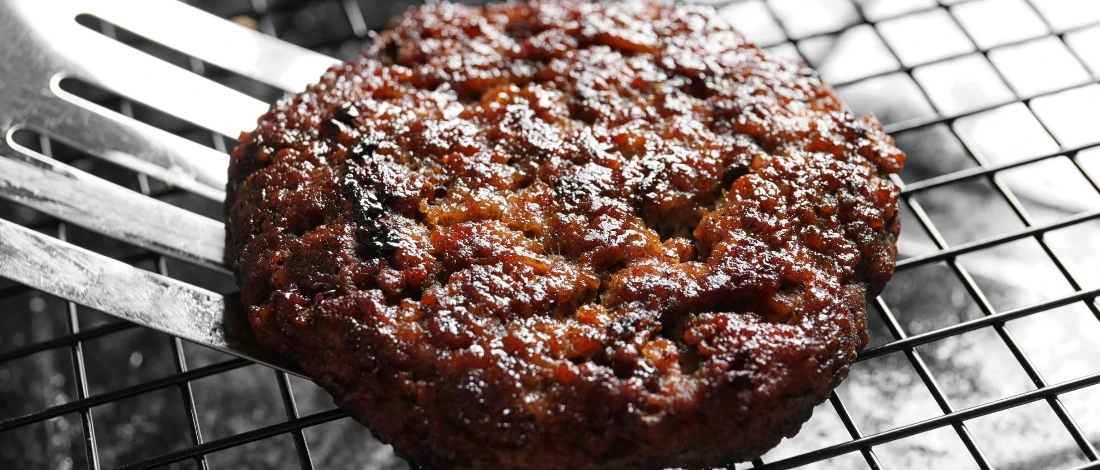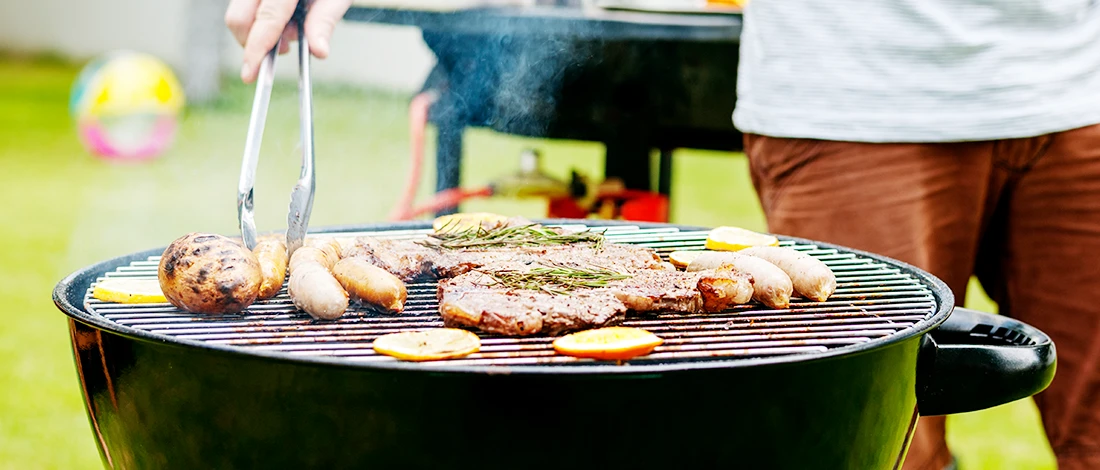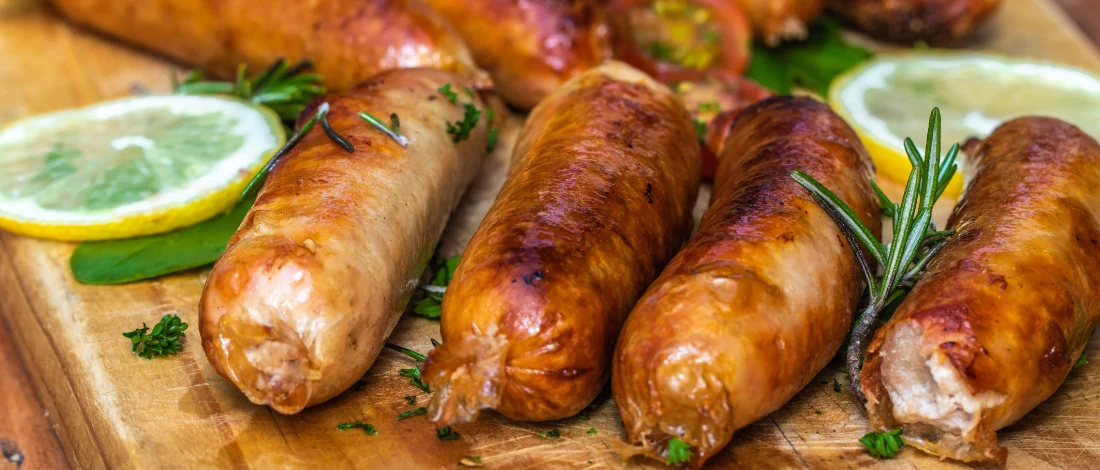As a devoted carnivore and pasta enthusiast who has been following a carnivore diet for over seven years, I understand the joy of savoring the perfect combination of meat and pasta.
Pesto pasta is one of my favorites, but I’ve discovered that the final flavor depends on the meat you pair it with.
I've experimented with various meat options to find out what works best for this classic Italian dish.
In this article, I will share my top ten types of meat that pair best with pesto pasta, ensuring that you'll find a pasta and meat combo to suit your taste and preferences.
Quick Summary
- Pesto pasta is a delicious dish that pairs well with various types of meat.
- You can eat pesto pasta with beef, pork, poultry, or seafood. Some even use meatloaf mix.
- Marinate the meat in lemon juice for the best flavors.
What Meat Goes With Pesto Pasta?

Chicken, turkey, ground beef, and various seafood options go with pesto pasta.
Pesto pairs well with various kinds of meat, so you can experiment and choose what you like best.
However, finding the best meat for pesto sauce can be difficult because pesto has bold flavors that can overpower milder and lighter meats.
You should carefully choose meat that can stand up to the pesto sauce.
Here are the 10 best rich and flavorful meat options to pair with pesto pasta.
1. Chicken
Chicken is one of the best types of meat to have with pesto pasta. It’s high in protein and low in fat and has a mild taste, so it won’t overpower the taste of the pesto sauce [1].
The spice and saltiness of pesto pair well with chicken, especially thicker pieces.
The trick when using chicken for pesto pasta is to use the right amount so the pesto isn’t too overpowering and there’s not too much chicken that you lose the pesto flavor. I recommend going for a ratio of one pound of chicken to 1/4 cup of pesto.
Prepare chicken for pesto pasta by cooking it on the stovetop, in the oven, or making a rotisserie chicken.
You can also grill chicken if you have a smoky flavor in your pesto sauce. Cook chicken until it reaches 160 degrees, then add to your pasta [2].
“As an excellent low-calorie, low-sodium, and low-fat source of protein, chicken provides important nutrients throughout our lives—from pregnancy through our later years.”
- National Chicken Council
2. Ground Beef
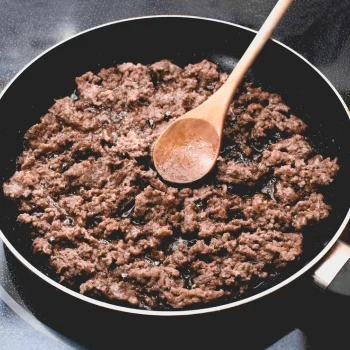
Ground beef is another great option for pesto pasta. It’s a versatile meat, rich in flavor, and easy to cook.
Choose ground beef with a good fat content for the best results. Fat ensures the meat doesn’t turn dry, chewy, or grainy.
The fat helps the meat remain moist and blend well with the pesto.
Pro tip: If you’re using lean ground beef, marinade it with olive oil or bone broth before cooking to add more moisture while the meat cooks.
Beef has a stronger flavor compared to chicken, but it balances well with the pine nuts and cheese in the pesto pasta.
Brown ground beef on the stove before adding it to pasta.
3. Steak
Steak also combines well with the pesto pasta sauce. It has a beefy flavor that pairs well with salty pesto flavors.
Steak is a flavorful cut, but pesto is also rich in flavors, so neither will overpower the other.
Fry the steak on the stove with olive oil. Cook according to your preference.
Once the steak is done, let it rest for a few minutes, then slice or chop and add to the pasta. Use one pound of steak for 1/2 cup of pesto.
4. Pork Chops

Choose pork chops if you want a more meaty flavor in your pesto pasta.
For example, pork chops are milder than bacon or sausage, but you’ll still have a noticeable meaty taste and texture.
You can season pork chops to your preference. Stick to basic salt and pepper, or add garlic if you want a stronger flavor.
Fry pork chops on the stove with some olive oil for a juicy texture.
You can also get a juicy texture by cooking them in the oven. Once cooked, chop the meat into small pieces and add to your pasta.
5. Bacon
Bacon is full of flavors. It's rich in smoky and salty flavors that nicely offset the bold pesto flavors.
Cook bacon on the stovetop in a pan, in an oven, or on a grill until it turns golden brown and crispy.
Make sure to flip it every two to three minutes.
Once cooked, chop the bacon into small pieces and add to your pasta. You can also dice bacon before cooking and then just mix it into the cooked pasta.
Note: Bacon is already very salty, so don’t add more salt to your pasta.
6. Shrimp

It has a mild flavor that pairs well with earthy pesto without overpowering it.
Shrimp sweetness balances the pesto saltiness, so you get a balanced pesto pasta.
You can grill or saute shrimp for pesto pasta. In case you opt for grilling, make sure not to overcook it.
Cook shrimp for a few minutes. Remove it from heat as soon as the shrimp turns pink. In case you saute the shrimp, add some oil to the pan and cook on medium heat.
7. Tuna
If you’re in a hurry or don’t want to cook any meat, tuna is the best option. All you need to do is open a can of tuna, drain the liquid, and add tuna to the pesto sauce.
You can also warm up the tuna first in a pan with a little liquid. Make sure not to keep it on heat too much, or it’ll turn dry.
Tuna gives pesto pasta a mild fishy flavor that works well with fresh pesto flavors. Plus, it breaks down easily, so it’s easy to mix and eat it with pasta.
You can also buy tuna and cook it yourself if you want it fresh. Sear it on the outside with some oil in the pan. Cook for two minutes per side.
8. Lobster

Lobster has a similar texture to shrimp when added to pesto pasta. However, it’s sweeter and meatier than shrimp.
Lobster sweetness is a great addition to aromatic, salty pesto.
You can buy frozen lobster, canned, or fresh tails. Keep in mind that frozen and canned lobster already has salt, so don’t overseason the pasta.
9. Turkey
Similarly to chicken, turkey also has a mild flavor and isn’t as overpowering as steak pesto pasta or ground beef pesto pasta.
Its flavor is somewhat stronger than chicken, with earthy notes that pair great with basil and garlic in pesto.
You can cook turkey breasts on the stove and then chop them into pieces, or cook ground turkey with olive oil.
10. Veal
Veal tenderness gives pesto pasta great texture and the flavor pairs well with the earthy and nutty pesto flavor.
Cook veal on the stovetop until just tender. Let it rest for 10 minutes, and slice into steaks before adding to pasta salads.
Related Articles:
3 Tips on Choosing the Right Meat for Pesto Pasta

Here’s how to choose the right meat for pesto pasta:
- Choose based on the season - If you’re eating pesto pasta in summer, go for grilled chicken or shrimp. But, if you’re cooking it in winter, use ham or leftover turkey from the holidays.
- Choose based on flavor - If you want pesto pasta rich in flavors, go for beef, turkey, or steak. But if you want a milder taste, use chicken breast.
- Choose based on other ingredients - If you’re making garlic bread and tomato sauce with your pesto sauce, go for meat with milder flavors, such as chicken breast. This way, you’ll have fewer flavors competing with each other.
3 Tips on Cooking the Meat for Pesto Pasta for the Best Flavor
Here’s how to cook the meat for pesto pasta for the most flavor:
- Marinate - Marinate the meat before cooking to make sure it stays juicy and has a lot of flavors. Place the meat in a ziplock bag with seasonings of your choice, and let it marinate for a few hours or even overnight.
- Use spices and herbs - Add spice when cooking meat to boost the flavor. Use red pepper flakes, garlic, or other favorite spices. You can also add fresh herbs for a brighter flavor. Basil, oregano, and thyme work great.
- Grill or fry the meat - Most meats that go with pesto pasta can be grilled or fried. Make sure to keep an eye on the internal temperature and not overcook, or you’ll have dry meat.
FAQs
Can You Put Meat in Pesto Pasta?
Yes, you can put meat in pesto pasta. Some of the best meats that go with pesto sauce include beef, chicken, shrimp, bacon, and more.
What Do Italians Eat With Pesto Pasta?
Italians don’t eat pesto sauce with pasta. Italians eat lasagna, potato gnocchi, or minestrone. Pesto pasta is popular in other countries.
What Cheese Goes With Pesto Pasta?
Cheese that goes with pesto pasta is parmesan cheese, mozzarella, ricotta, cream cheese, and parmigiano reggiano.
References:
- https://www.nationalchickencouncil.org/policy/nutrition-health/
- https://www.usda.gov/media/blog/2011/05/25/cooking-meat-check


